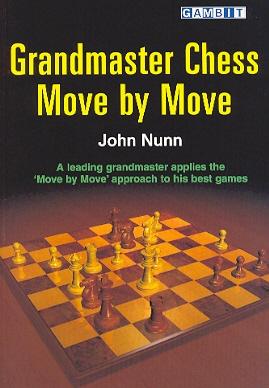
Edward Winter

The back cover of Grandmaster Chess Move by Move by John Nunn (London, 2005) describes him as ‘arguably the most highly acclaimed chess writer in the world’, and here we offer some reflections on certain aspects of his output and on how he differs from most chess authors.
A polymath, Nunn has written authoritative monographs on openings, endings and compositions, as well as annotated games collections and autobiographical volumes. As an annotator he is equally at home presenting lucid prose descriptions for the relative novice and analysis of extreme depth for the expert. He has also penned a fair amount of topical commentary and discussion material, though this has seldom appeared in book form. In 2003 he retired from tournament play, and the Introduction to Grandmaster Chess Move by Move (page 6) describes it as ‘a final volume on the last part of my career’.
Fortunately, his writing career continues apace. For the subject matter of his books he is notably disinclined to take the low road. Not for him the production of an instant match-book or a quick throw-together on whichever master is the biggest box-office draw of the day. One indulgence is to lure with the frequent use of ‘secrets’ in his book titles: Secrets of Grandmaster Play, Secrets of Grandmaster Chess, Secrets of Practical Chess, Secrets of Rook Endings, etc. Although he is a fine teacher, writing straightforward prose without effets de style, a few of his books may be too detailed for any but the most dedicated student, yet even chess enthusiasts who will never peruse, or open, the 320-page tome Secrets of Pawnless Endings (1994) should find it gratifying that a work of such quality exists.
Having no interest in endlessly, or even occasionally, trotting out Morphy v the Duke and Count (‘not an especially good game’, he wrote on page 4 of Learn Chess), Nunn is the antithesis of those chess hacks who survive, more or less, on a diet of low-hanging fruit. Chess books are littered with factual errors thoughtlessly copied from author to author, but copying is not in Nunn’s nature, and his desire not to err is particularly pronounced. Every writer makes mistakes, of course, but not every writer makes an effort to avoid doing so. Few writers take such pains as does Nunn to reduce the risk of error to a minimum.
Intelligence, decency and perfectionism are hallmarks of Nunn, and his views on the average sludge of journalism, which is devoid of all three hallmarks, are hard to dispute. ‘Jimmy Nunn’ was the rendition of his name in a newspaper as far back as 1966, and on page 12 of Secrets of Grandmaster Chess he commented, ‘My opinion of the accuracy of journalists took a nose-dive and has been going down ever since’.
Given Nunn’s versatility in his book production, it may seem paradoxical to attribute to him a strong sense of self-restraint and the ability to rein himself in, yet we consider these to be key factors in his success. His range is vast, but he does not regard his accumulation of talents as a passe-partout for use throughout the entire realm of chess literature. His incursions into chess history, for instance, are relatively rare, but when he does wade in (a notable example being the ‘test of time’ chapter in John Nunn’s Chess Puzzle Book, which scrutinized the quality of play at Carlsbad, 1911) the terrain is selected with care, he ensures that he is briefed to the gills, and the result is something fresh.
The high standards which Nunn demands of himself have been reflected too in his cautious approach to annotating the games of other masters, for even here, on what may be regarded as his home ground, he does not want to let his readers, or himself, down. Below is part of a contribution he made in 1985 to C.N. 993:
‘When I was younger, my games were occasionally annotated in magazines by other players. I was astonished to see what they wrote; indeed, on some occasions, I could scarcely believe that it was the same game. When I started annotating games myself I began to see how difficult it is to write about other players’ games. Of course, one can restrict oneself to essentially trivial comments, or fall back on the usual clichés, but really to penetrate the reasoning of another player is very hard. It is correspondingly valuable when one does gain a fresh insight by analysing games, but this requires a great deal of time which is not always available.’
Yet Nunn is not staid or unadventurous. Without courting controversy, he has no qualms about speaking his mind. As long ago as 1991 he was deploring ‘The Decline of British Chess’ (on pages 20-23 of the January 1991 BCM). His article prompted exchanges in that publication (March 1991, pages 114-115 and April 1991, page 171) and brought him a hands-down victory (against, it must be said, feeble opposition). Now, an essay in Grandmaster Chess Move by Move (pages 270-277) entitled ‘The State of the Chess World’ finds Nunn casting his net more widely, with, inter alia, deft but pointed strictures about the World Chess Federation which are infinitely more potent than any amount of the more customary anti-FIDE squawking.
When in possession of a rock-solid case, he does what any truthful author is glad to do: dire tout haut ce que les autres pensent tout bas. Few, if any, Batsford authors in the early 1990s were prepared to criticize publicly (as Nunn did, on pages 26-27 of the German publication ChessBase Magazin, July-August 1991) the lamentable Batsford Chess Encyclopedia, a would-be flagship which capsized the moment it left the slipway. Nunn’s article on ‘Chess Publishing and the Batsford Story’ on pages 278-285 of Grandmaster Chess Move by Move provides a further grisly reminder of what B.T. Batsford Ltd. was like for much of the 1980s and the early 1990s. Even today, such insiders’ stories are a rarity, but Nunn has the facts and is prepared to share them.
Naturally enough for someone who is ‘arguably the most highly acclaimed chess writer in the world’, in most of Nunn’s books he stands as the sole author. Where he has worked on somebody else’s book, for the production of an algebraic edition (an exercise involving more pitfalls than might be thought), the outcome has not always been happy. The most regrettable case, the My 60 Memorable Games débâcle in the mid-1990s, was by no means his sole responsibility but it entailed uncharacteristic lapses of judgment, both pre- and post-publication. When describing in Grandmaster Chess Move by Move a string of inglorious Batsford doings, Nunn had a golden opportunity (or, indeed, a golden obligation) to include a belated word of contrition about the Fischer episode, and it is inexpressibly disappointing that, a decade on, he still felt unable to do so, passing over the aberration in silence.
Given Nunn’s propensity for keeping a firm hand on the controls, it is no surprise that nowadays he writes and produces books for his own company, Gambit Publications Ltd. Despite a certain sameness in many Gambit books (if a dozen of them were randomly opened on a table, could even the Gambit editorial team identify who had written which?), the company has justly built up a reputation for quality which no British chess publisher has enjoyed since the heyday of G. Bell and Sons.
Nunn’s contribution to chess literature continues but has already been immense. Some writers create order and help chess knowledge to advance; others create disorder and obstruct such progress. In the former category Nunn is pre-eminent, and perhaps uniquely so.
(4218)
John Nunn’s involvement with Batsford was also discussed in an article entitled ‘Ex Acton ad Astra’ on pages 18-33 of the Spring 2007 issue of Kingpin.
Regarding its editorial panel for chess books, Batsford’s refusal to change a waning team proved fatal for the company.
Grandmaster Performance by L. Polugayevsky (translated by Kenneth P. Neat) is an absolutely splendid games collection which confirms the Soviet master as one of the world’s most entertaining annotators. He manages to get everything right – that complicated balance of tone, depth, style, etc. One highlight of the book is his game against Geller at Skopje, 1968, where a weird ending of queen v two bishops is brilliantly discussed, closing with the remark, ‘This is possibly the most meticulous analysis I have ever made in my life’. A warmly recommended book.
(892)
John Nunn (London) writes:
‘In C.N. 892 you recommended Grandmaster Performance by Polugayevsky, but this book is one example of a recent and disturbing trend amongst chess publishers, namely the duplication of material. The ending with Geller you admired was already published in Grandmaster Preparation with, so far as I can see, identical commentary. Some games are absolutely identical (e.g. No. 61) while many others had already appeared in the chapter on adjournment analysis in Grandmaster Preparation. In these cases the earlier moves are tacked on, but the analysis of the interesting post-adjournment phase is exactly the same. A casual flick through the book would probably not reveal this fact to a potential buyer and anyone who purchased Grandmaster Performance on the strength of the earlier work must have suffered considerable disappointment. It is unfortunate that what would otherwise have been an excellent pair of books should be marred in this way. Botvinnik’s Half a Century of Chess can also be criticized on these grounds.’
(1005)
From Kenneth Neat (Durham, England):
‘I refer to John Nunn’s comments on the duplication of material in Polugayevsky’s books Grandmaster Preparation and Grandmaster Performance (C.N. 1005). The original manuscript for the latter contained 64 games, of which 16 complete games and parts of nine other games had already appeared in Grandmaster Preparation. When it was pointed out to the author that this was not acceptable, he commented that in the USSR it was quite in order to publish a book with as little as 30% (!) new material. Nevertheless, he agreed to remove 13 games and to supply annotations to 13 new games, but he asked that a few of the other duplicates, which were particularly “special”, should be retained. As a result, the proportion of new material in Grandmaster Performance is not less than 85%.
I do not quite understand why Dr Nunn extends his criticism to Half a Century of Chess. The Russian version of this contained 100 games spanning Botvinnik’s entire career, and in the Pergamon translation the last 10 of these were (with some reluctance) omitted, precisely in order to avoid duplication with Pergamon’s earlier publication Selected Games 1967-1970.’
(1175)
John Nunn replies:
‘In C.N. 1175 Dr Neat refers back to some critical comments I made which appeared in C.N. 1005. I did not mention Dr Neat’s name either directly or by implication in the original comments and, indeed, I have high regard for his skills as a translator. However, since he has chosen to defend Pergamon’s policy in print, I would like to reply and offer a more detailed explanation of my criticism.
Dealing first with Polugayevsky’s Grandmaster Performance, I still maintain that the word-for-word duplication of material from Grandmaster Preparation is likely to be a source of irritation to purchasers. A careful measurement of the repeated material shows that it constitutes the equivalent of 29 pages, or almost exactly one-sixth of Grandmaster Performance. Grandmaster Preparation justifiably received very favourable comments from reviewers and must have sold well in Britain; undoubtedly many people bought the sequel after being impressed by the quality of Grandmaster Preparation. Since the repeated material lies towards the end of Grandmaster Performance, a prospective purchaser would be unlikely to notice the duplication during a casual examination in a bookshop. I therefore felt it my duty as a reviewer to point this out (as I did in the Illustrated London News, for example) and I was surprised that the favourable comments in Chess Notes failed to mention this important feature of the book. Hence my letter to you which appeared in C.N. 1005.
Speaking personally now, rather than as a book reviewer, I can see no justification for copying 29 pages from a book aimed at a similar readership and produced by the same publisher only a couple of years later.
My criticism of Botvinnik’s Half a Century of Chess is somewhat different and relates to the general policy of Pergamon and, to a lesser extent, other British chess publishers. The introduction to Half a Century of Chess starts, “Several books of my games have appeared in English in the past”. I am not sure which other books Botvinnik is referring to, but I will only mention the two books which I read as a young player, namely One Hundred Selected Games (Dover, 1960, based on an English translation originally produced in 1951) and Botvinnik’s Best Games 1947-70 (Batsford, 1972), which does not repeat any material from the earlier Dover book.
The introduction to Half a Century of Chess does not point out that many of the games are repeated from the earlier English-language books. I think the average reader would conclude from the introduction that the book mainly consists of material which had not previously appeared in English. It was only after I had played through a number of games with a sense of familiarity that I compared Half a Century of Chess with the two earlier books. I found that 66 of the 90 games were duplicates. Moreover, although Botvinnik has reworded his annotations, the analysis is virtually identical. I could only find a handful of points at which Botvinnik had significantly revised his earlier opinions.
In Dr Neat’s letter he expressed surprise at Polugayevsky’s comment that it was in order to produce a book in the USSR with as little as 30% new material, yet that is substantially the situation we have with Half a Century of Chess. My criticism would be muted if the introduction had clearly stated that this was a “Best of Botvinnik” selection compiled largely from earlier publications, but unfortunately this was not pointed out.
A tremendous amount of effort goes into the translation and production of a chess book, so it is sad that this energy is often expended in re-issuing familiar material. For example, Pergamon chose to reprint the Averbakh endgame series not long after Batsford had translated it into English. Admittedly Pergamon (and Dr Neat!) improved the translation, but 90% of the chess analysis is identical. Would not the British chess public be better served by translating the many excellent foreign-language books which would be wholly new to British readers? I am aware that publishers are in the business of making a profit, not serving the British chess public; but there may be a link between the two.’
(1264)
Comments to us by John Nunn about the finale of the first Karpov v Kasparov world title match were given in C.N. 1020. See The Termination.
John Nunn’s Solving in Style (London, 1985) is a carefully prepared, well-documented treatise on chess problems and studies. It aims to bridge the gap between over-the-board players and the composing fraternity and is written by somebody who has done exactly that with great distinction. Dr Nunn is the only British Grandmaster to have written books of consistent quality.
(1069)
The ICCA Journal is a very well produced quarterly publication from the International Computer Chess Association (Maastricht, the Netherlands).
The July-September [1988] issue, just out, is another excellent one. The contributors’ erudition is such that a fair amount will pass over the non-specialist’s head. There is, however, a most entertaining article entitled ‘Life with ChessBase’ by John Nunn, explaining how a grandmaster uses technology in his preparation.
(1784)
John Nunn (London) writes:
‘Everybody knows the chess aphorism concerning the player who commented that he had never beaten a healthy opponent, but who originally said this and what was the exact quote? I have asked several grandmasters, and received a range of answers. Most went for Tartakower, but in the back of my mind I have the idea that it was Bogoljubow.’
(2051)
From pages 54-55 of the February 1891 BCM:
‘Few men will admit the superiority of an opponent, and he who loses finds generally something in himself to account for defeat; or, as Löwenthal once remarked to me, “He always has a doctor's certificate in his pocket!”’
The writer was Charles Tomlinson.
(2118)
When C.N. s 2051 and 2118 were reproduced in Kings, Commoners and Knaves we added the following (see pages 322-323):
In reply to C.N. 2051 a number of readers referred us to an (unsubstantiated) assertion by B.H. Wood in the 1949 Illustrated London News and reprinted on page 10 of Reinfeld’s The Treasury of Chess Lore that Amos Burn ‘was heard to remark plaintively towards the end of his long life that he had never had the satisfaction of beating a perfectly healthy opponent’.
The same passage (with a repetition of the word ‘never’) was reproduced by Wood on page 78 of CHESS, January 1952, but it has not been possible to find any link between the quote and Amos Burn.
Now, however, we note that page 2 of Chess Pie, 1936 had an article entitled ‘Humours of Chess’ by E.B. Osborn (‘Literary Editor of the Morning Post’). It concerned H.E. Bird (‘most lovable of all the old masters’), with whom he was personally acquainted. Osborn remarked:
‘Dear Old Bird would say that he had hardly ever beaten a healthy player.’
The question which thus arises is whether B.H. Wood, writing over a decade later, had the Osborn article in mind but mistakenly referred to Burn instead of Bird.
(4189)
See too C.N. 11510.
Historical Havoc quotes John Nunn from page 69 of the 1/1991 New in Chess:
‘I like to see some evidence that the author has really done some work for his book. You see a lot of books these days where you think, “Well, did this take two weeks or two and a half weeks to write?”.’
John Nunn’s Best Games (London, 1995; a 320-page paperback) has already been eulogized by many critics, and deservedly so. C.N. has frequently had harsh words for Batsford’s productions, but here is a superlative autobiographical games collection whose hallmarks are depth, clarity and common sense.
(2078)
For the reasons set out in a review that we contributed to Kingpin in 1996 (see The Games of Alekhine), Alexander Alekhine’s Best Games by Alexander Alekhine with additional material by C.H.O’D. Alexander and John Nunn (London, 1996) was an unfortunate production.
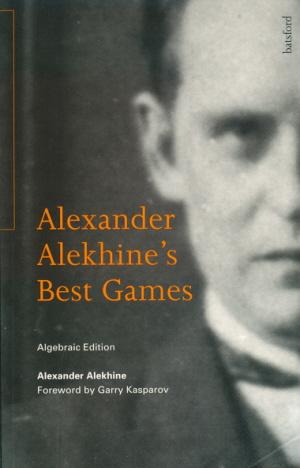
On page 235 of Grandmaster Chess Move by Move (London, 2005) John Nunn gave the following position from his game against L. Keitlinghaus in the 2002/3 Bundesliga:
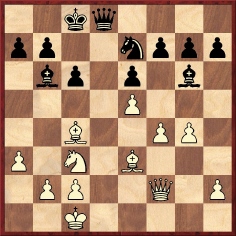
Nunn played 19 Bc5 and commented:
‘In my book Secrets of Practical Chess, I introduced the term “collinear move” to describe a move such as this, in which two opposing pieces face each other, and one slides along the line of attack without capturing the enemy piece For some reason such moves are very easy to overlook.’
In Secrets of Practical Chess (1998) it was on pages 55-57 that Nunn discussed ‘collinear moves’, noting that ‘they are even more difficult to spot when the attacked piece moves away from the attacking piece’. As an illustration he gave Tal v Fischer, Curaçao, 1962 (16...Bb5).
(4230)
Marek Soszynski (Birmingham, England) mentions that page 70 of a book he co-authored with Jan Przewoznik, How to Think in Chess (Milford, 2001), noted John Nunn’s term ‘collinear move’, while page 234 suggested that the following example of ‘collinearity’ was possibly ‘the move of the book’:
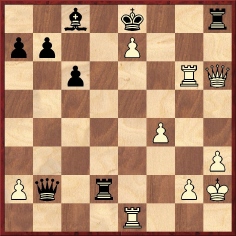
G. Maróczy v M. Romi, San Remo, 25 January 1930
White played 41 Qh5 and won.
(4233)
As mentioned in C.N. 4218 above, on page 12 of his book Secrets of Grandmaster Chess (London, 1997) John Nunn reported that in a 1966 newspaper his name came out as ‘Jimmy Nunn’. (‘My opinion of the accuracy of journalists took a nose-dive and has been going down ever since.’)
It could have been worse. From page 71 of Il lessico degli scacchi by Yuri Garrett (Brescia, 2012):

(8101)
In Kingpin in 1998 we quoted the relevant passage from page 12 of Secrets of the Grandmaster Chess:
‘After this event [the Richmond Easter Congress, 1966] my photograph appeared in the Putney & Roehampton Herald, where my name was incorrectly given as “Jimmy” Nunn (a correction appeared the week after). My opinion of the accuracy of journalists took a nose-dive and has been going down ever since.’
Asked about chess books which had a profound influence on him, John Nunn replied (see the 3/2002 New in Chess, page 98):
‘When I was a young player, I read The Most Instructive Games of Chess Ever Played by Irving Chernev which made chess seem extremely easy. However, I then read Alekhine’s Best Games of Chess, which made chess seem impossibly difficult. I eventually discovered that the truth lies somewhere between the two.’
Dr Nunn informs us:
‘I was referring to the 1924-37 volume by Alekhine. I recall being particularly impressed by 18...Nxf2 in Rubinstein v Alekhine, Semmering, 1926, or rather the fact that Alekhine must have seen it some time in advance.’
(8196)
Richard Réti’s remark that Emanuel Lasker ‘often deliberately plays badly’ was given in the section on the former world champion in Masters of the Chess Board (London, 1933); on page 124 of the German edition (Mährisch-Ostrau, 1930) the wording was ‘Lasker spielt oft absichtlich schlecht’. See too pages 404-405 of A Chess Omnibus, as well as C.N. 6889. We should like to give the full text of Réti’s original article (‘published after the New York tournament of 1924’).
A detailed study of Lasker’s play has just been published, John Nunn’s Chess Course (London, 2014), and it is unmissable.
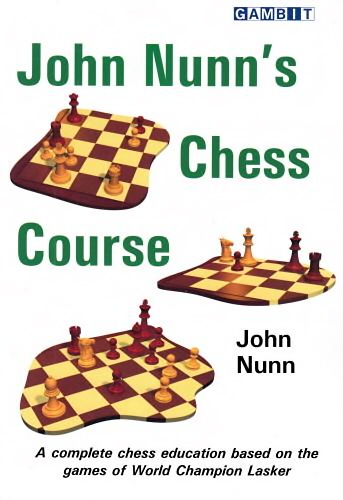
In his Introduction (page 7) Nunn writes:
‘... the myth has developed that many of Lasker’s wins were based on swindles, pure luck or even the effect of his cigars. In reality, there was nothing mystical or underhand about his games; they were based on a deep understanding of chess, an appreciation of deceptive positions and some shrewd psychology. Another myth for which there seems no real evidence is that Lasker deliberately played bad moves in order to unsettle his opponents. Certainly Lasker played bad moves, as all chessplayers do from time to time, but the point which struck me when analysing his games was how often he adopted a safety-first strategy. Lasker was a great fighter and had a strong will to win, but his winning efforts hardly ever crossed the boundary into recklessness; in almost every case, he played moves that appeared provocative but were no worse than the alternatives, with the important difference that they were more likely to induce a mistake.’
(8660)
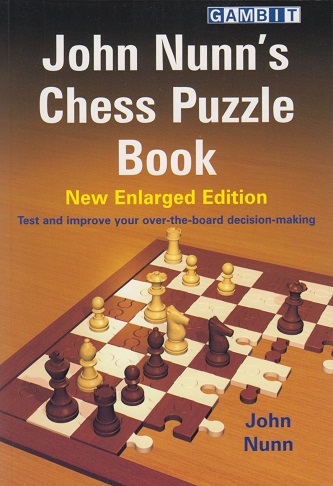
The enlarged edition of John Nunn’s Chess Puzzle Book (London, 2009) has been translated into Russian (Moscow, 2012), and we have a copy with an inscription by Vladislav Tkachiev:
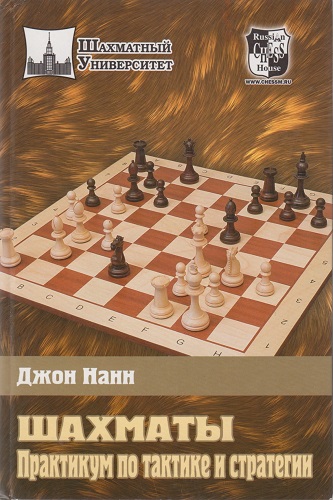
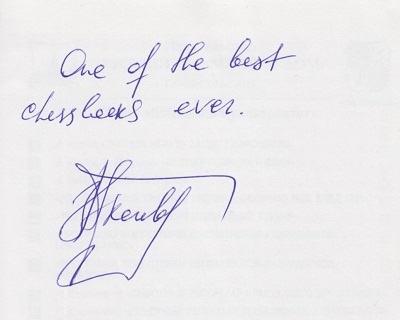
(9148)
Leonard McLaren (Onehunga, New Zealand) points out a remark by John Nunn on page 53 of Understanding Chess Middlegames (London, 2011), in the section on planning:
‘Perhaps the most important advice is that if you can’t think of a good plan, at least don’t play a bad one.’
(9201)
See Chess Planning.
Included in our nominations for the best chess books ever:
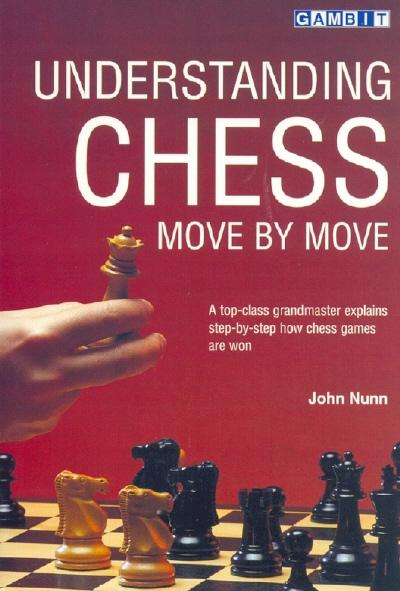
Understanding Chess Move by Move by John Nunn. Published by Gambit, London in 2001. Softback, 240 pages. Price $19.95/£14.99. Thirty instructive games annotated virtually move by move and with impeccable clarity.
From page 18 of Nunn’s Secrets of Practical Chess (London, 1998):
‘When analysing a given position, it is fair to say that one almost always sees more in the first five minutes than in the next five minutes. The five minutes after that is even less productive, and so on. I have observed that if a player spends more than 20 minutes over a move, the result is almost always a mistake. The normal decision-making process should not take longer than this, even in fairly complex situations.’
From August 2022 to November 2024 the English Chess Federation publication ChessMoves featured a series of articles by John Nunn entitled ‘Great British Chess Players’.
All are accessible online. The complete list (no articles in the December 2022 and August 2024 issues):
August 2022-November 2022: McDonnell, Staunton, Bird, Blackburne;
January 2023-July 2024: Burn, Gunsberg, Atkins, Sultan Khan, Thomas, Yates, Menchik, Alexander, Golombek, Wade, Penrose, Miles, Nunn, Speelman, Mestel, Chandler, Short, Adams, Sadler;
September 2024-November 2024: McShane, Jones, Howell.
(12165)
To the Chess Notes main page.
To the Archives for other feature articles.
Copyright: Edward Winter. All rights reserved.